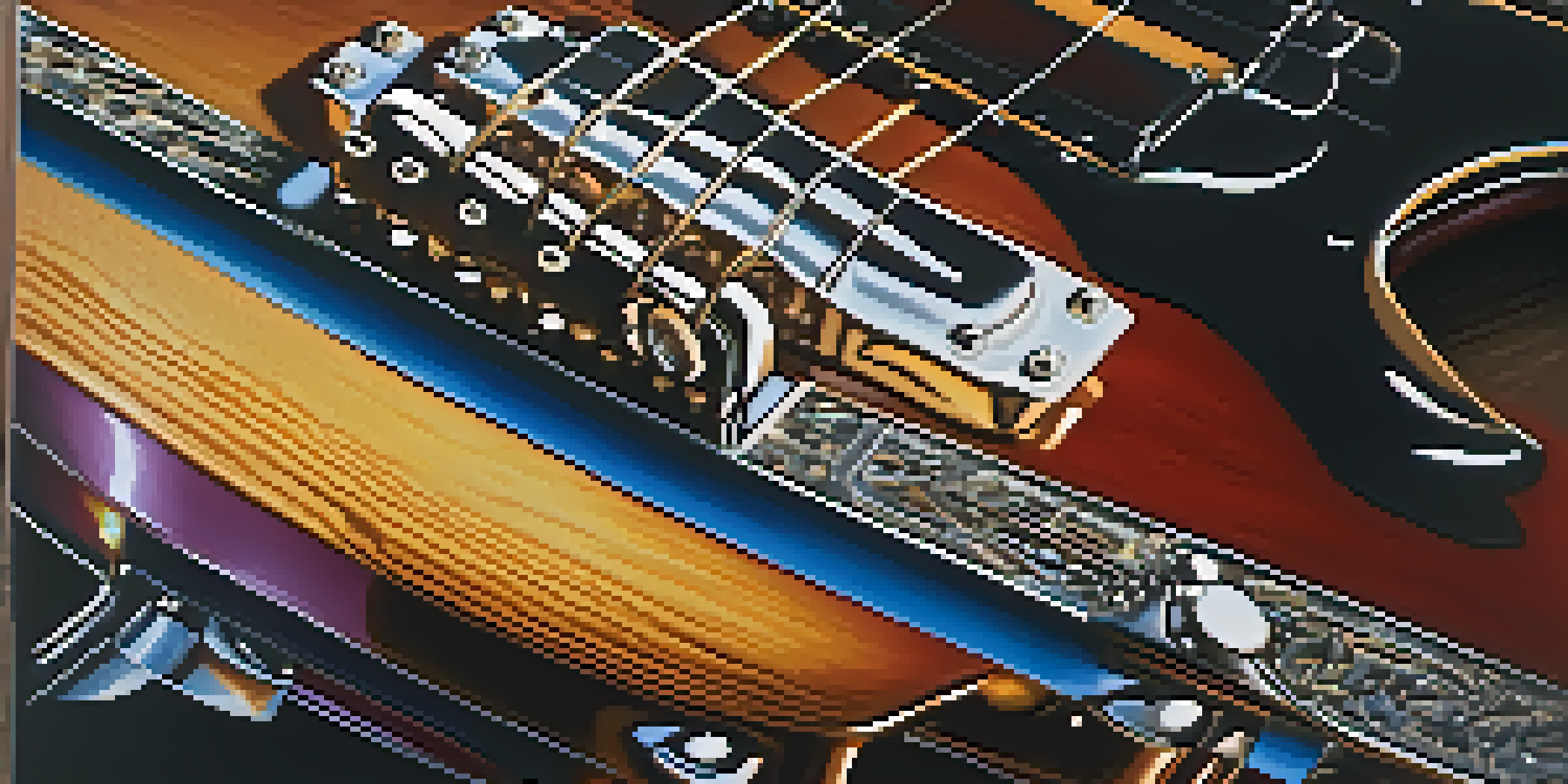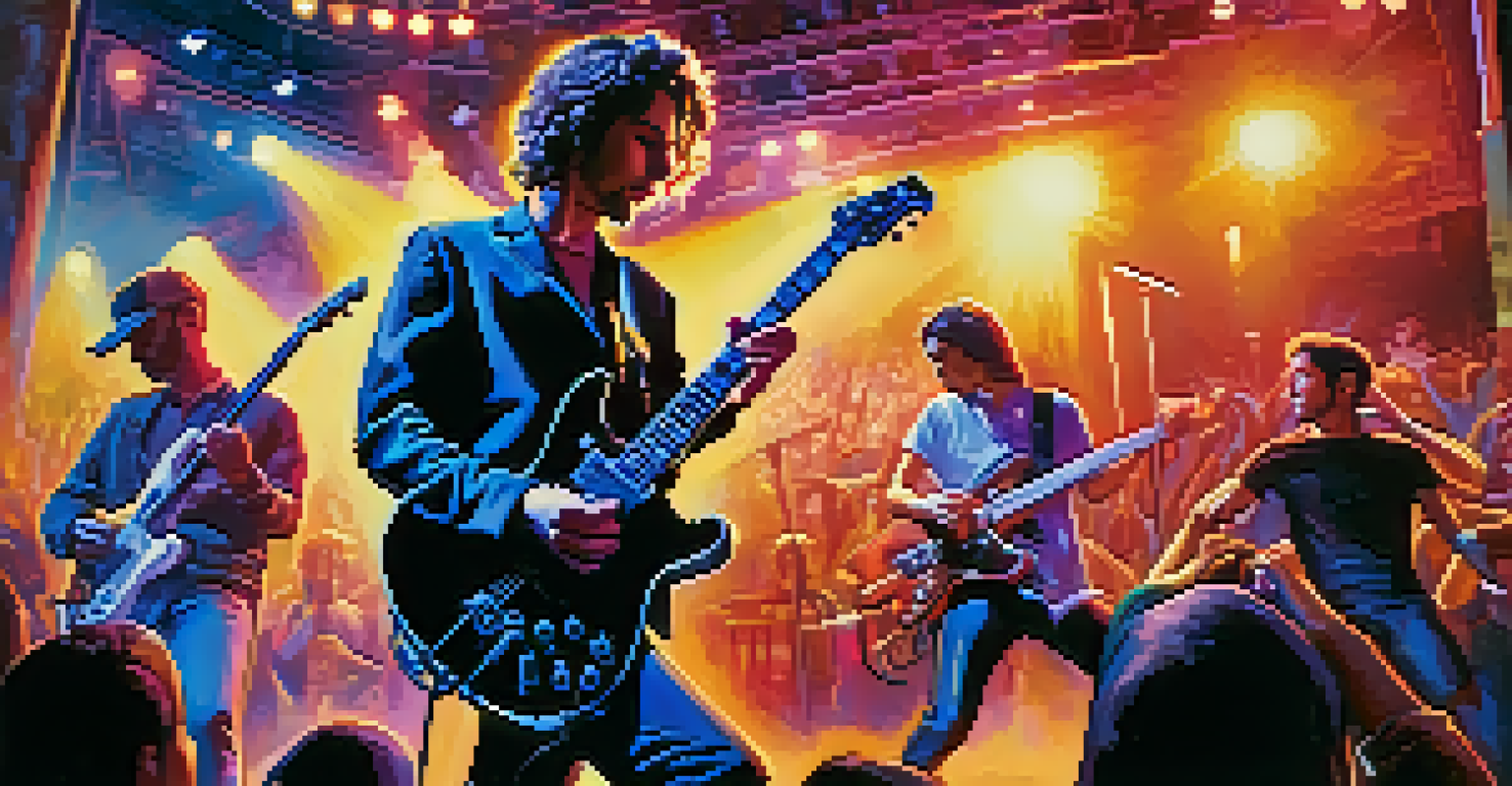Alternative Rock: The Evolution of Guitar Sounds

The Birth of Alternative Rock and Its Sonic Roots
Alternative rock emerged in the 1980s as a response to mainstream pop and rock, offering a fresh sound that diverged from the norm. Bands like R.E.M. and The Cure began to experiment with guitar tones and structures, crafting songs that resonated with a generation seeking authenticity. Their music often featured jangly guitars and introspective lyrics, creating a unique atmosphere that set the stage for future innovations.
Alternative rock is about taking risks and pushing boundaries, creating something that resonates with truth and authenticity.
This genre drew inspiration from punk rock's raw energy and post-punk's atmospheric soundscapes. The use of unconventional guitar tunings and effects pedals became a hallmark of alternative rock, allowing artists to explore new sonic territories. As the genre gained traction, it paved the way for diverse sub-genres, each contributing its own signature guitar style.
Ultimately, the early days of alternative rock laid the groundwork for a dynamic evolution in guitar sounds. This evolution would see the genre morph and adapt, reflecting the changing tastes and cultural landscapes of the times. The initial experimentation with guitar tones was just the beginning of a much larger journey.
The Grunge Movement: Gritty Sounds Define a Generation
The 1990s grunge movement ushered in a new era for alternative rock, characterized by its heavy, distorted guitar sounds. Bands like Nirvana, Soundgarden, and Pearl Jam utilized powerful power chords and aggressive riffs, combining punk's rawness with metal's intensity. This gritty sound resonated deeply with the angst and disillusionment of youth during that decade.

Grunge guitarists embraced a do-it-yourself ethic, often using cheap gear to create their iconic sounds. The use of effects like fuzz, distortion, and feedback became essential in crafting a 'dirty' aesthetic that defined the genre. The iconic sound of Nirvana’s 'Smells Like Teen Spirit' is a prime example of how these elements came together to create anthems that captured the spirit of a generation.
Alternative Rock's Diverse Evolution
Alternative rock has evolved through various sub-genres, each shaping its unique sound and reflecting cultural shifts.
As grunge became mainstream, its influence extended beyond music, affecting fashion and culture at large. The heavy guitar sounds of this era not only defined the genre but also inspired countless artists to explore similar sonic textures. Grunge’s raw energy and authenticity continue to inspire musicians today.
Post-Grunge and the Rise of Alternative Pop Rock
Following the grunge explosion, the late 1990s and early 2000s saw the rise of post-grunge and alternative pop rock. Bands like Foo Fighters and Matchbox Twenty blended catchy melodies with the heavier guitar tones that had become synonymous with the genre. This fusion brought a more polished sound while still retaining the emotional depth of alternative rock.
The guitar is not just an instrument; it's a means of emotional expression, a voice that speaks louder than words.
Guitar sounds during this time often featured a mix of clean and distorted tones, allowing for a broader range of expression. The use of harmonized guitar lines and layered riffs became common, creating a rich tapestry of sound. This era also saw the increasing integration of acoustic elements, providing a contrast to the heavy electric guitars.
As alternative pop rock gained popularity, it opened the door for a new wave of artists who would continue to evolve guitar sounds in exciting ways. The emphasis on melody and hooks made the genre appealing to a wider audience, further solidifying alternative rock's place in mainstream music. This transition marked a significant shift in how guitar-driven songs were crafted.
The Emergence of Emo: Emotional Expression Through Guitar
Emo, a sub-genre of alternative rock, emerged in the late 1990s and early 2000s, characterized by its emotive lyrics and intricate guitar work. Bands like My Chemical Romance and Dashboard Confessional popularized the genre, often incorporating complex chord progressions and melodic guitar lines. The guitar became a key instrument for conveying deep emotional experiences.
One defining feature of emo guitar sounds is the use of arpeggios and fingerpicking, creating a delicate and introspective atmosphere. This style often contrasts with the raw power of grunge, offering a more reflective approach to songwriting. The blending of clean and distorted tones allowed for dynamic shifts that enhanced the emotional impact of the music.
Grunge's Impact on Music and Culture
The 1990s grunge movement defined a generation with its heavy guitar sounds and raw authenticity, influencing music and fashion.
Emo's influence can still be felt today, as many contemporary artists draw inspiration from its unique guitar techniques. The genre's focus on vulnerability and personal storytelling resonates with audiences, making it a lasting part of alternative rock's evolution. Emo's legacy continues to shape the way guitarists approach songwriting and sound.
The Influence of Technology: Digital Sounds in Alternative Rock
As technology advanced, it began to significantly influence guitar sounds in alternative rock. The introduction of digital effects and recording techniques allowed artists to experiment with sound in ways previously unimaginable. Bands like Radiohead embraced this technology, integrating synthesizers and electronic elements into their music, reshaping the sound of the genre.
The use of software and digital plugins enabled musicians to create intricate soundscapes, blurring the lines between traditional rock and electronic music. This shift allowed for greater creativity and innovation, with guitarists exploring new textures and effects. The result was a fresh take on alternative rock, one that appealed to both old fans and new listeners alike.
Technology continues to play a vital role in the evolution of guitar sounds, as artists now have access to a plethora of tools to craft their music. The blending of genres and experimentation with sound has led to an exciting era for alternative rock, where anything is possible. This ongoing evolution keeps the genre vibrant and relevant in today's music landscape.
The Revival of Garage Rock: Raw Guitars Make a Comeback
In recent years, the revival of garage rock has brought a fresh wave of energy to alternative rock, emphasizing raw guitar sounds and straightforward songwriting. Bands like The White Stripes and The Strokes have embraced a lo-fi aesthetic, harkening back to the genre's roots. This movement celebrates simplicity and authenticity, often steering away from the polished production of earlier years.
Garage rock guitarists often favor gritty, overdriven tones, reminiscent of the punk and grunge eras. The use of basic chord progressions and catchy riffs creates an accessible sound that resonates with a wide audience. This return to rawness has allowed new artists to emerge, reinvigorating the alternative rock scene.
Technology Transforms Guitar Sounds
Advancements in technology have led to innovative guitar sounds in alternative rock, merging traditional and electronic elements.
The garage rock revival highlights the cyclical nature of music, where trends often come full circle. As audiences crave authenticity, the straightforward approach of garage rock serves as a reminder of the emotional power of unrefined guitar sounds. This resurgence continues to influence the direction of alternative rock today.
The Future of Alternative Rock: Evolving Guitar Innovations
Looking ahead, the future of alternative rock promises exciting innovations in guitar sounds. As new technologies emerge and musical boundaries continue to blur, artists will undoubtedly explore uncharted territories. The blending of genres and incorporation of diverse influences will shape the next wave of alternative rock, keeping it fresh and relevant.
Musicians are increasingly experimenting with unconventional instruments and sounds, pushing the limits of traditional guitar music. From loop pedals to unique tunings, the possibilities are endless for creative expression. This willingness to innovate ensures that the guitar will remain a vital component of alternative rock, even as its sounds evolve.

In this ever-changing landscape, one thing is certain: alternative rock will continue to thrive. The genre's ability to adapt and embrace new ideas has been its strength, allowing it to resonate with generations of listeners. As artists forge ahead, they will undoubtedly continue to redefine what guitar sounds can mean in the realm of alternative rock.